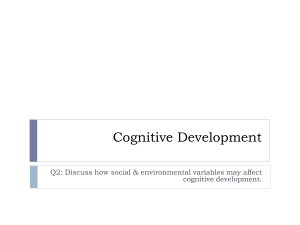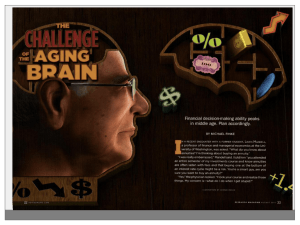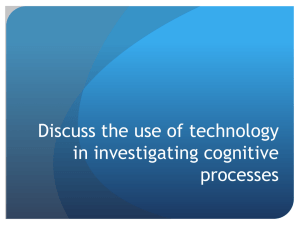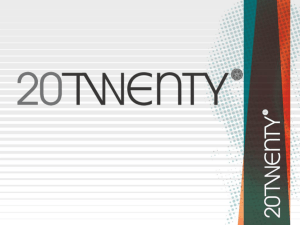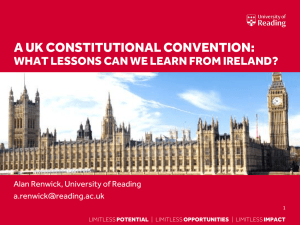Cognitive load theory for teachers
advertisement
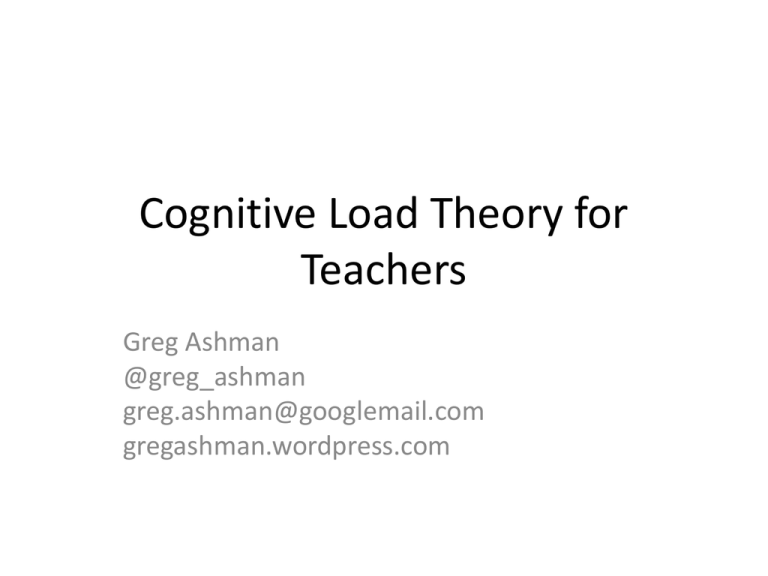
Cognitive Load Theory for Teachers Greg Ashman @greg_ashman greg.ashman@googlemail.com gregashman.wordpress.com I am not a researcher • I am going to give a simplified version of cognitive load theory that emphasises its application to teaching • I will not be discussing intrinsic, extraneous and germane cognitive load although these terms appear in the literature. However, you should be aware that there is a debate surrounding the concept of germane cognitive load. [For more information: Sweller, John. "Element interactivity and intrinsic, extraneous, and germane cognitive load." Educational psychology review 22.2 (2010): 123-138.] • I will undoubtedly annoy the purist by conflating terms (e.g. working and short-term memory), conflating ideas (such as processing and memory) and not discussing the detail of working memory. Sorry. Do you think you could remember the following number for the length of this presentation? 456251 What about this number? 992244782438 The number of items that you can remember like this is limited (without special training). Miller (1956) first determined it to be about five to nine items. [Miller, George A. "The magical number seven, plus or minus two: some limits on our capacity for processing information." Psychological review 63.2 (1956): 81.] The bottleneck in your head Long-term memory Effectively limitless Working Memory constrained We can visualise the mind as being made of different components. Two of these are working (or short-term) memory and long-term memory. There are others e.g. sensory memory. These are not meant to correspond to specific, physical regions of the brain. The bottleneck in your head Long-term memory Effectively limitless Working Memory constrained The working memory roughly corresponds to what we are conscious of. It is severely constrained. This capacity varies between individuals and depends upon what we are doing with the items. What is an “item”? Recalling the number example, imagine that I asked you to remember six letters for the next half an hour: GFXTQN In this case, each letter is an item Long-term memory Effectively limitless Working Memory GFXTQN constrained What is an “item”? Imagine that I asked you to remember a different six letters: SPIDER This is only one item because you have a concept of “spider” in your long-term memory. A key feature of working memory is that its limitations can be overcome in this way by long-term memory: “chunking” Long-term memory Effectively limitless Working Memory constrained [Ericsson, K. Anders, and Walter Kintsch. “Long-term working memory.” Psychological review 102.2 (1995): 211.] Chunking: Knowledge is what you think with The bottleneck in your head Long-term memory Effectively limitless Working Memory New Learning constrained New ideas, information and procedures must first be processed in the working memory before passing into the long term memory The bottleneck in your head Long-term memory Effectively limitless Working Memory New Learning constrained Too many items to process leads to cognitive overload and learning stops The bottleneck in your head Long-term memory Effectively limitless Working Memory Problem response constrained Problem solving, analysis or any complex task draws on resources from long term memory (chunking) to reduce what needs to be processed in working memory The bottleneck in your head Long-term memory Effectively limitless Working Memory Problem response constrained If there is little of relevance in the long term memory then everything will need to be processed in the working memory leading to cognitive overload Can you always “just Google it”? • Perhaps we don’t need students to learn factual information any more because – should they need it – they can find it on the internet. • However, this ‘search’ process will occupy working memory, leaving less capacity to process and evaluate what is found. • In addition, factual information on the internet cannot be used for chunking (as in the spider example) in the same way as factual information in the long term memory. [For a more detailed discussion: Hirsch Jr, E. D. "You can always look it up—or can you." American Educator24.1 (2000): 4-9.] A puzzling phenomena I often teach maths students how to solve simultaneous equations like this: 𝑥+𝑦 =5 2𝑥 − 𝑦 = 4 There are two standard approaches that both involve first finding one of the unknowns, 𝑥 and then finding the other, 𝑦. I often find that students launch into the procedure, find 𝑥 and then stop, thinking that they have finished the question even though they haven’t found 𝑦. Why is this? I used to think it was carelessness… Five-in-the-bed New Item Working Memory Five-in-the-bed New Item Working Memory I must also solve for y Old Item This could have been quite important... What is the solution? Practice. The more the students practice the procedure for solving simultaneous equations, the more automatic it will become and the less working memory they will need to devote to it, freeing up space to remember key features of the question such as that they must also find 𝑦. Think of driving / walking / cycling to work. The first time that you did this, you had to think about it a great deal but the procedure has now passed into your long-term memory and been made automatic, allowing you instead to daydream… An example from writing A student can highlight the grammatical mistakes in a paragraph that she is given. However, the paragraphs that she writes herself are full of the same grammatical mistakes. Is this carelessness? It is possible that the process of constructing writing so occupies the working memory that there is no space left to check grammar. Possible solution: A discrete phase of writing followed by a discrete phase of proof-reading to separate the two tasks. Complex Contexts Reasons for use • Show why ideas are relevant in the real world. • Demonstrate the cutting-edge of our subject. • Potentially motivating. Examples - Solving a maths problem about the cost of cars at different dealerships. - Creating a news report on the situation in the Middle East - Designing and conducting a scientific investigation Yet -> Rich contexts increase cognitive load Complex Contexts Cognitive load theory predicts: Two successful strategies - Teacher guides students through the context in a highly structured way, pointing out what is important and what is irrelevant, modelling this thinking - Simple contexts that are limited in scope are used early in learning and the teacher guides students towards more complex contexts Less successful strategies - Students are asked to decide upon salient points for themselves without full teacher guidance e.g. problem-based learning Opinion – confusion is not motivating Kirschner, Sweller and Clark In 2006, a paper was published by Paul Kirschner, John Sweller and Richard Clark. They argued that instructional strategies that avoided the teacher guiding students through the salient points of a new concept were in conflict with what we know about cognitive load. The strategies that they criticised were: Constructivist, Discovery, Problem-Based, Experiential, and Inquiry-Based Teaching This set the cat amongst the pigeons, generated a number of responses, led to a conference and even a book. Opinion: This paper is a must-read for all teachers [Kirschner, Paul A., John Sweller, and Richard E. Clark. "Why minimal guidance during instruction does not work: An analysis of the failure of constructivist, discovery, problem-based, experiential, and inquiry-based teaching."Educational psychologist 41.2 (2006): 75-86.] Forget theory: I know what works! Do you? To borrow from John Hattie, everything works. When we test an intervention in a school setting we virtually always find a positive result. Why? Because many variables go into teaching. New interventions are often adopted by enthusiastic teachers who believe in the intervention. Even in randomised, controlled trials – the gold standard of such research – it’s pretty hard to ‘blind’ the trial. Participants – teachers and students – know whether they are part of the intervention or not and will have expectations associated with that. Hattie’s Analysis • John Hattie’s method is controversial because he groups together very different kinds of trials and calculates an ‘effect size’. An effect size of zero would represent no effect and 1 represents a very large effect. • Because ‘everything works’, Hattie doesn’t simply look for positive effect sizes, he looks for those above 0.4. • Instructional strategies that are predicted to be successful by cognitive load theory fare well in this analysis; the strategies criticised by Kirschner, Sweller and Clark do not. • For instance, direct instruction and mastery learning have high effect sizes (0.59 and 0.57) whereas inquiry-based learning and problem-based learning have low effect sizes (0.31 and 0.15) [Hattie, John. Visible learning: A synthesis of over 800 meta-analyses relating to achievement. Routledge, 2013.] Project Follow Through Unfortunately named. Hands-up if you have heard of it? • Origin as an extension of Lyndon Johnson’s 1960s “Headstart” program for pre-school children • Idea was to improve teaching of disadvantaged first graders (hence the “follow through” from pre-school) • Funding was dramatically cut by congress so instead of a mass intervention it was decided to run it as a experiment with different sponsors pitting their approaches against each other • It remains the largest and most expensive experiment in education history Project Follow Through Many programs were tested. A large number were based upon constructivist and ‘child-centred’ ideas about learning that were (and are!) popular with educationalists. A couple of interventions were labelled ‘basic skills programs’ by the researchers and one of these was the DISTAR direct instruction program, led by Zig Engelmann. Although there was large variation between the effectiveness of the programs from site to site, the ‘basic skills’ programs were clearly found to be the most effective, with direct instruction the most effective of all. Misconception Direct instruction was labelled a ‘basic skills’ program because it emphasised things like basic arithmetic. This has led to the misconception that direct instruction is good for teaching basic skills but not for things like problem solving and that it may harm motivation. In fact, direct instruction produced the largest gains in problem solving skills and in self-esteem in the Project Follow Through experiment. Yet proponents of alternative approaches continue to criticise direct instruction on these grounds and claim that constructivist or child-centred approaches are more effective. Project Follow Through Carl Bereiter and Midian Kurland put it well: “When child-centered educators purport to increase the selfesteem of disadvantaged children and yet fail to show evidence of this on the Coopersmith Self-Concept Inventory, we may ask what real and substantial changes in self-esteem would one expect to occur that would not be reflected in changes on the Coopersmith? Similarly for reasoning and problem-solving. If no evidence of effect shows on a test of non-verbal reasoning, or a reading comprehension test loaded with inferential questions, or on a mathematical problem solving test, we must ask why not? What kinds of real, fundamental improvements in logical reasoning abilities would fail to be reflected in any of these tests?” Direct instruction did have an effect on these measures. [Bereiter, Carl, and Midian Kurland. "A constructive look at Follow Through results." Interchange 12.1 (1981): 1-22.] Do we get similar results today? In a 2004 paper, Kroesbergen and colleagues report on a trial conducted in the Netherlands. Low-achieving maths students were given either no intervention, a constructivist intervention where the students’ own strategies for solving problems were surfaced and explored, or an explicit intervention where a teacher directly taught problem-solving strategies. Students in both interventions improved but those given the explicit instruction improved the most. [Kroesbergen, Evelyn H., Johannes EH Van Luit, and Cora JM Maas. "Effectiveness of explicit and constructivist mathematics instruction for low-achieving students in the Netherlands." The Elementary School Journal (2004): 233-251.] But do they know it better? The claim is often made that explicit instruction is good for short-term tests but that strategies where students have to generate their own ideas produce better longterm gains, more understanding or better transfer to other types of problem. This is hard to test and there is a mix of evidence. However, one interesting paper compared students who had learnt the scientific principle of controlling variables by discovering it themselves with those who had been explicitly taught it. There was no difference in the two groups’ capacities to analyse science fair posters in a later test of transfer. [Klahr, David, and Milena Nigam. "The equivalence of learning paths in early science instruction effects of direct instruction and discovery learning."Psychological Science 15.10 (2004): 661-667.] Summary • Cognitive load theory suggests that we pay attention to what we are asking students to process in their working memories; cognitive load • Early in learning, we can minimise cognitive load by guiding students; modelling for them what they should pay attention to and why • We can also minimise cognitive load by starting in simple – perhaps more abstract – contexts before building to complex or more real-life situations • Cognitive load theory is supported by lab-based psychology research and its predictions are confirmed by large-scale educational research Any Questions? Greg Ashman @greg_ashman greg.ashman@googlemail.com gregashman.wordpress.com






